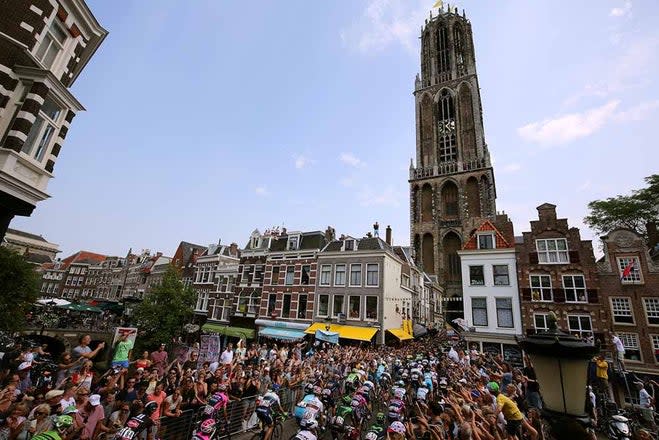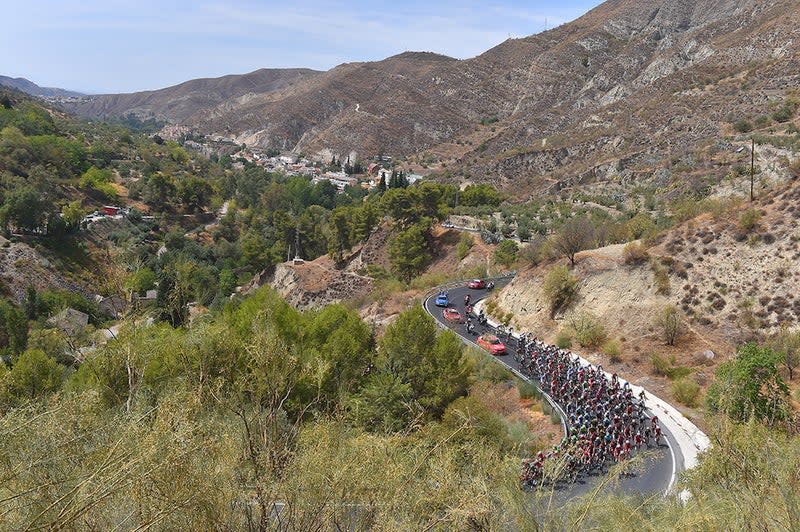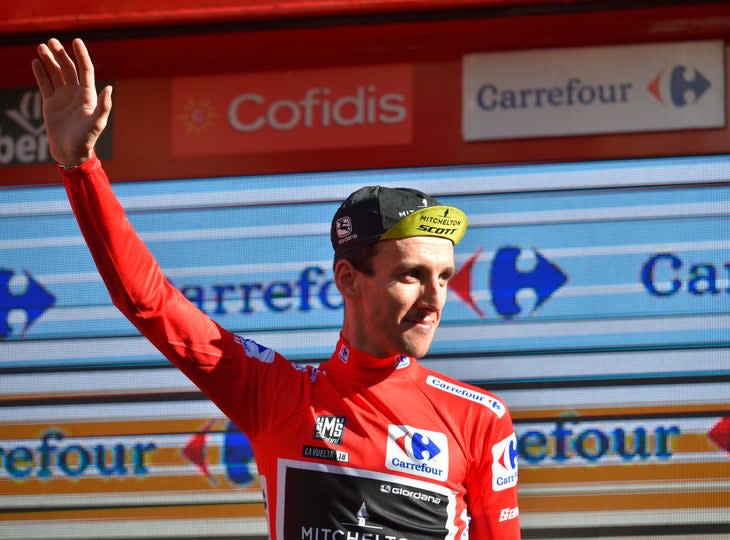Vuelta a España preview: Fireworks assured even without the ‘Big Four’
- Oops!Something went wrong.Please try again later.
- Oops!Something went wrong.Please try again later.
- Oops!Something went wrong.Please try again later.
Velo News
77th Vuelta a Espana
August 19 in Utrecht, Netherlands, to September 11 in Madrid
21 stages -- one TTT, one ITT, eight summit finales
23 teams, eight riders each
Primoz Roglic joked during the Tour de France that July is simply the best preparation for the Vuelta a Espana.
Indeed, July has served the Jumbo-Visma Slovenian star well, as he’s won three consecutive red jerseys at the season’s third grand tour.
The 2022 Vuelta ramps up later this month with a wide-open start list that likely might not include any of cycling’s “Big Four.” Roglic is part of that rarified company, along with Tadej Pogacar (UAE Team Emirates), Jonas Vingegaard (Jumbo-Visma), and Egan Bernal (Ineos Grenadiers).
Those four are at the very pointy end of the WorldTour peloton, and it’s likely none of them will be at the start in Utrecht on August 19.
The coming-off-injury Roglic is still in wait-and-see mode, while Bernal is almost assured not to race as he hasn’t competed since 2021 and his devastating impact with a bus in January. Pogacar and Vingegaard are both confirmed non-starters.
So what does that leave the Vuelta, the season’s third and typically most wildly unpredictable grand tour?
A lot.
Without the likely presence of any of the peloton’s confirmed grand tour jefes, the Vuelta could and should be a lot better off.
Why? Because new faces and fresh narratives will elbow their way into the frame. Professional cycling is an endless game of musical chairs. The objective is to have a seat at the table, and end up at the top of the heap.
The Vuelta is both a stepping stone to greater things and a confirmation of arrival. Be it a young whipper-snapper confirming their grand tour chops -- think no further than Pogacar and his spectacular three stage-win grand tour debut in 2019 -- or a dogged veteran like Chris Froome joining the three-win grand tour sweep club, the Vuelta is an essential jewel in any WorldTour crown.
Also read:
There will be plenty of contenders for what’s typically one of the most contested races of the year.
Jai Hindley (Bora-Hansgrohe) and Richard Carapaz (Ineos Grenadiers) will be favorites, along with the likes of Ben O’Connor (Ag2r-Citroen), Simon Yates (BikeExchange-Jayco), Mikel Landa (Bahrain Victorious), Joao Almeida (UAE Team Emirates) and Remco Evenepoel (Quick-Step Alpha Vinyl) all coming in with late-season aspirations to win stages and spice up the GC.
Americans will be represented with Sepp Kuss (Jumbo-Visma) and Brandon McNulty (UAE Team Emirates) both being given their chance to stretch their GC legs in a grand tour.
Let’s dive in -- venga!
Week 1: Vuelta sticks to its blueprint

The Vuelta might be venturing to the Netherlands for its grande salida for three stages in Europe’s flattest country, but the Spanish grand tour is living up to its reputation as being a climber’s grand tour.
Two time trials -- an opening team time trial on stage 1 and a 31.1km individual time trial on stage 10 -- will try to counter the scales, but the balance tips toward the peloton’s sleekest and most aggressive climbers.
No fewer than eight summit finales and a few more climb-stacked transition stages means that the 2022 Vuelta winner won’t be tipping the scales at more than 70kg.
This Vuelta is made for climbers.
After the opening day TTT, stages 2 and 3 will go to the fast men of the peloton. As of the writing of this story, the final start lists are not yet defined, but many of the top sprinters who blazed to victories at the Giro d’Italia and Tour de France won’t be racing. Instead, riders like Tim Merlier (Alpecin-Deceuninck), Pascal Ackermann (UAE Team Emirates), and Kaden Groves (BikeExchange-Jayco) will be in the fray.
🔙 Reiniciamos. Todo empieza de nuevo 🔥
🔙 Everything starts again 🔥
📆 19/8 - 11/9
❤️🔜 #LaVuelta22 pic.twitter.com/kVzrtCeMSz
-- La Vuelta (@lavuelta) August 8, 2022
Stage 4 and the first of three rest days brings the Vuelta to Spain’s Basque Country, and the real fun begins. The notorious climbs of the Cantabrian range of northern Spain are featured in the first full week and will go a long toward defining who will and will not win.
An uphill kicker in stage 4 and the jigsaw profile in stage 5 in the hilly Basque Country could see Alejandro Valverde (Movistar) try to win early in his final Vuelta adios.
The first summit finale comes early at the stage 6 climb up Pico Jano, with two first-category climbs stacked up in the final to spit any pretenders to the Vuelta throne very early.
Only the Vuelta would feature a first-category climb midway in a “sprinter’s stage,” but that’s what the peloton faces in stage 7 to Cisterna. The next day goes to one of the Vuelta’s new climbs at Collau Fancuaya deep in the heart of Spain’s Asturias.
The Vuelta does a great job scouring social media and climbing apps to find these hidden gems, and bring them into the WorldTour. Stage 9 features a short but brutally steep wall at Nava to end the first week with a sting.
Week 2: The heat is on

A very long transfer -- about 8 hours at least for the bus drivers -- carries the peloton from the cool and relatively cozy confines of northern Spain to the sun-baked beaches of the Mediterranean.
Stage 10 sees the Vuelta’s lone ITT, running 31.1km from Elche to Alicante that, at least in late August, will likely see scorching temperatures. The second half of the Vuelta will work against anyone who cannot perform in the heat.
Stage 11 should be another one for the sprinters, with the Vuelta’s first major climb in the south set for stage 12 ending atop the first-category Penas Blancas above Estepona. The south-facing 20km climb will be catching the blazing summer sun.
Stage 13 could go to the sprinters, but a lumpy profile will give breakaways some hope. Back-to-back summit finale spice up the weekend. Stage 14 hits the Sierra la Pandera above Jaen, a short and explosive climb that will favor anyone with legs going into the final week to make a stand for red.
The famed long drag to the Sierra Nevada closes out the second week. The 25km-plus grinder is more of a race of attrition, but after two full weeks in the legs, cracks will be appearing.
Week 3: Plenty of traps still in play

The final week of the Vuelta might not feature any of the race-makers like the Angliru or Lagos de Covadonga, but the stage profiles could set the stage for some traps and landmines for strong teams and weak opposing rivals.
The third week opens with stage 16 in a rolling stage that will be a battle between breakaways and sprinters, and there’s no letup in stage 17 with second-category ramps Monasterio de Tentudia. It’s often these shorter, more explosive finales that can produce more fractures than long, grinding climbs, especially late in a grand tour.
This Vuelta is relentless with another Cat. 1 summit finish at Alto del Piornal in stage 18, followed by a short, two-climb stage to Talavera de la Reina that could prove hard to control.
The penultimate climbing stage across the mountains north of Madrid is classic raid country at the Vuelta, and will cover some of the same roads where Fabio Aru caught out Tom Dumoulin in the 2015 Vuelta. The 175.5km 20th stage from Moralzarzal Puerto de Navacerrada features two passages up the deceptively steep Navacerrada summit.
Fireworks are guaranteed the traditional sprint finish at the Plaza de Cibeles in the heart of historic Madrid.
For exclusive access to all of our fitness, gear, adventure, and travel stories, plus discounts on trips, events, and gear, sign up for Outside+ today.]]>

